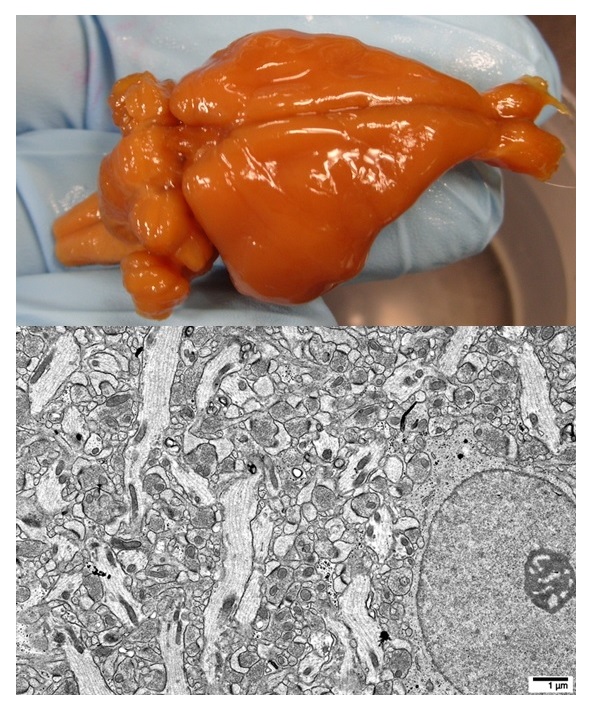Scientists have thawed the rabbit's brain in close to perfect condition.
A team of scientists led by a graduate of the Massachusetts Institute of Technology Robert McIntyre managed to freeze the brain of a small mammal and restore it to a state close to perfect. The Brain Conservation Foundation awarded the team the Small Mammal Brain Preservation Prize.

Scientists are investigating cryopreservation from the 17th century, when experiments on freezing animals hibernating for the first time began in winter. English scientist John Hunter in the XVIII century, put forward the theory of the extension of human life due to cyclical freezing and thawing. At the end of the 19th and the beginning of the 20th century, the Russian physicist and biologist Porfiry Ivanovich Bakhmetyev investigated the phenomena of anabiosis and hypothermia of animals. He developed a thermoelectric thermometer to measure the temperature of insects and showed that recovery from anabiosis is possible if tissue fluids remain in a liquid state.
The man was first cryonized in 1967. He was a psychology professor, James Bedford, who was dying of kidney cancer with lung metastases. In 2010, experiments on the creation of cryosna technology for the soldiers began DARPA .
')
In 2015, Natasha Vita-Mor from the American University of Advanced Technologies and Daniel Barranko from the cryobiotechnology division of the Spanish University of Seville have proved that the use of cryonics does not destroy the long-term memory of the simplest multicellular organisms — in this case, Caenorhabditis elegans were worms.
In Caenorhabditis elegans worms, the nervous system consists of 302 cells. And the human brain contains 86 billion neurons, which makes it harder for scientists to preserve it. Cryopreservation should save long-term memory so that you can then restore the brain or load it into the machine.
In order to achieve the ability to preserve the human brain, scientists experiment with other mammals. In 1995, the biologist Yury Pichugin froze sections of the rabbit brain, after defrosting, the sections retained their bioelectric activity. In a new study from a graduate of the Massachusetts Institute of Technology, scientists cryonized a whole rabbit brain, and then restored it with minimal damage.

The technology, which was proposed by a team of scientists at 21 Century Medicine, showed that the cryoprotector is able to protect against the formation of ice crystals even at a slow decrease in brain temperature to minus 130 degrees Celsius. The team was able to maintain neural connections after it had frozen the brain. Scientists filled the brain's vessels with special chemicals that fixed the neurons, cooled the brain, and then warmed up and removed these substances.
"Every neuron and synapse looks perfectly preserved all over the brain," says neuroscientist Kenneth Hayworth , president of the Brain Conservation Foundation, who awarded the prize. The judges of the Foundation were convinced of this with the help of electron microscopy. Fund co-founder John Smart commented to Motherboard that for the first time, the procedure retained everything that neuroscientists consider to be involved in learning and memory.

Scientists are investigating cryopreservation from the 17th century, when experiments on freezing animals hibernating for the first time began in winter. English scientist John Hunter in the XVIII century, put forward the theory of the extension of human life due to cyclical freezing and thawing. At the end of the 19th and the beginning of the 20th century, the Russian physicist and biologist Porfiry Ivanovich Bakhmetyev investigated the phenomena of anabiosis and hypothermia of animals. He developed a thermoelectric thermometer to measure the temperature of insects and showed that recovery from anabiosis is possible if tissue fluids remain in a liquid state.
The man was first cryonized in 1967. He was a psychology professor, James Bedford, who was dying of kidney cancer with lung metastases. In 2010, experiments on the creation of cryosna technology for the soldiers began DARPA .
')
In 2015, Natasha Vita-Mor from the American University of Advanced Technologies and Daniel Barranko from the cryobiotechnology division of the Spanish University of Seville have proved that the use of cryonics does not destroy the long-term memory of the simplest multicellular organisms — in this case, Caenorhabditis elegans were worms.
In Caenorhabditis elegans worms, the nervous system consists of 302 cells. And the human brain contains 86 billion neurons, which makes it harder for scientists to preserve it. Cryopreservation should save long-term memory so that you can then restore the brain or load it into the machine.
In order to achieve the ability to preserve the human brain, scientists experiment with other mammals. In 1995, the biologist Yury Pichugin froze sections of the rabbit brain, after defrosting, the sections retained their bioelectric activity. In a new study from a graduate of the Massachusetts Institute of Technology, scientists cryonized a whole rabbit brain, and then restored it with minimal damage.

The technology, which was proposed by a team of scientists at 21 Century Medicine, showed that the cryoprotector is able to protect against the formation of ice crystals even at a slow decrease in brain temperature to minus 130 degrees Celsius. The team was able to maintain neural connections after it had frozen the brain. Scientists filled the brain's vessels with special chemicals that fixed the neurons, cooled the brain, and then warmed up and removed these substances.
"Every neuron and synapse looks perfectly preserved all over the brain," says neuroscientist Kenneth Hayworth , president of the Brain Conservation Foundation, who awarded the prize. The judges of the Foundation were convinced of this with the help of electron microscopy. Fund co-founder John Smart commented to Motherboard that for the first time, the procedure retained everything that neuroscientists consider to be involved in learning and memory.
Source: https://habr.com/ru/post/371761/
All Articles